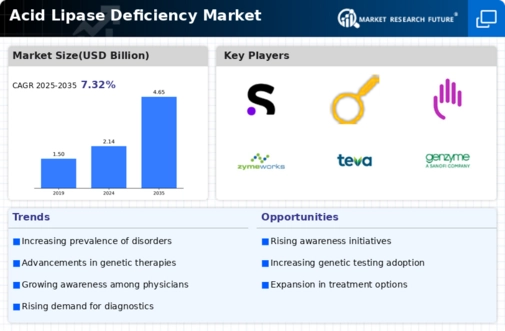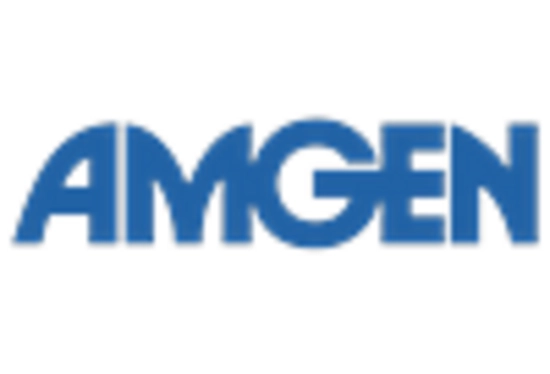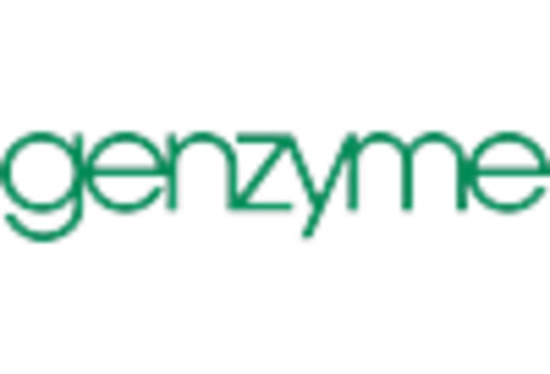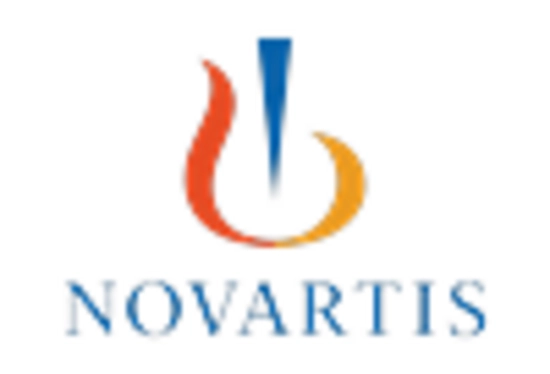Growing Investment in Rare Disease Research
The Acid Lipase Deficiency Market is benefiting from a surge in investment directed towards rare disease research. Pharmaceutical companies and research institutions are increasingly allocating resources to develop novel therapies for conditions like Acid Lipase Deficiency. This trend is supported by government initiatives and funding programs aimed at fostering innovation in rare disease treatment. The market for orphan drugs is projected to grow significantly, as stakeholders recognize the potential for high returns on investment in this niche area. As research progresses, new treatment options may emerge, enhancing the therapeutic landscape for Acid Lipase Deficiency and attracting further investment into the market.
Regulatory Support for Orphan Drug Development
Regulatory frameworks are becoming more supportive of orphan drug development, which is a crucial factor for the Acid Lipase Deficiency Market. Governments and regulatory bodies are implementing policies that incentivize the research and development of treatments for rare diseases. This includes expedited review processes, tax credits, and market exclusivity for successful drug candidates. Such supportive measures are likely to encourage pharmaceutical companies to invest in the development of therapies for Acid Lipase Deficiency. As a result, the market may witness an influx of new treatment options, enhancing the overall landscape for patients suffering from this rare metabolic disorder.
Technological Advancements in Diagnostic Tools
Innovations in diagnostic technologies are significantly impacting the Acid Lipase Deficiency Market. The development of advanced genetic testing and biomarker identification techniques has enhanced the accuracy and speed of diagnosis. These advancements allow for earlier detection of Acid Lipase Deficiency, which is crucial for effective intervention. The market for diagnostic tools is projected to grow, driven by the increasing demand for precise and rapid testing methods. Furthermore, the integration of artificial intelligence in diagnostic processes may streamline workflows and improve patient outcomes. As healthcare providers adopt these technologies, the overall market for Acid Lipase Deficiency diagnostics is likely to expand, reflecting a shift towards more efficient healthcare solutions.
Increasing Prevalence of Acid Lipase Deficiency
The rising incidence of Acid Lipase Deficiency is a notable driver in the Acid Lipase Deficiency Market. Recent estimates suggest that the condition affects approximately 1 in 40,000 to 1 in 100,000 individuals, indicating a growing patient population. This increase in prevalence is likely to spur demand for diagnostic and therapeutic solutions, thereby expanding the market. As healthcare providers become more aware of the condition, the number of diagnosed cases is expected to rise, further contributing to market growth. The need for effective management strategies and treatments for Acid Lipase Deficiency is becoming increasingly urgent, as patients seek improved quality of life and healthcare systems aim to address this rare metabolic disorder.
Rising Demand for Patient-Centric Treatment Approaches
There is a noticeable shift towards patient-centric treatment models within the Acid Lipase Deficiency Market. Patients and healthcare providers are increasingly advocating for personalized treatment plans that cater to individual needs and preferences. This trend is likely to drive the development of tailored therapies and management strategies for Acid Lipase Deficiency. As a result, pharmaceutical companies may focus on creating more effective and targeted treatments, which could lead to improved patient adherence and outcomes. The emphasis on patient engagement and satisfaction is expected to shape the future of the market, as stakeholders strive to meet the evolving expectations of patients and healthcare professionals alike.

















Leave a Comment